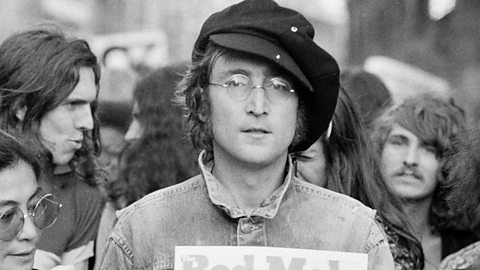How John Lennon was made into a myth
 Getty Images
Getty ImagesForty years ago today, the Beatles star was assassinated – and has since held a god-like status around the world. David Barnett looks at the many manifestations of him in popular culture.
John Lennon has been dead as long as he was alive – it was 40 years today that he was shot on the steps of the Dakota apartments in New York. And since his death, Lennon has achieved, as is typical for musicians who die young or in their prime, legendary status.
More like this:
But perhaps that's not right – or at least that’s not the whole story. As well as earning the tag "legend", which has perhaps lost some of its power because of its sheer ubiquity, Lennon has been elevated to something equally nebulous and folklorish; a myth.
 Alamy
AlamyLegends are for heroes. Myths are for figures even greater than that; gods. And John Lennon has indeed achieved a kind of deific immortality – thanks in part to the appropriation of his persona in works of fiction and drama. With portrayals of him that have cast him as everything from unemployed layabout to Labour Party leader, wise old fisherman to actual psychedelic godhead, Lennon's life has been romanticised, rehashed and rewritten since his death, to the point where the myth is often more real than the man. But more real doesn't necessarily mean more true. And the re-imagining of John Lennon began almost as soon as his life ended.
A misconceived saint
“Soon after Lennon's death – within hours, really – he was portrayed in this really sanctimonious, sanitised way that doesn't do justice to his personality, his sense of humour, or his fellow Beatles,” says Rob Sheffield, a writer for Rolling Stone magazine and the author of the 2017 book Dreaming The Beatles. "I always loved what Paul said in the 80s: 'Since his death he's become Martin Luther Lennon.'"
Naturally, the Dakota building became a focal point for fans in the days after the shooting, transformed into a sea of flowers and grief-stricken notes. Hundreds of people held a silent tribute on the steps of Washington DC's Lincoln Memorial. Radio stations played nothing but Lennon and Beatles songs for days, and record stores sold out of the Lennon-Ono album Double Fantasy. Meanwhile further afield, there was similar beatification going on: within days of his death, too, a mural appeared on a wall in a hidden side-street in Prague, which has been added to and embellished over the years to become a shrine. Despite efforts to remove it or have it covered over, it is now a major tourist attraction and regular stop on guided tours of the Czech capital.
"It's understandable that in the first flush of grief, people wanted to pretend he was a saint, but that's the last claim Lennon ever would have made for himself," says Sheffield. "In addition to everything else he was, he was the most caustic, sarcastic, withering wit in the music world. So it sells him short to portray him as a simple-minded optimist."
Lennon certainly wasn't a saint by any stretch of the imagination. Five years ago, a legal document emerged featuring a statement from Dorothy Jarlett, Lennon's housekeeper when he was married to his first wife Cynthia, which painted the star as a serial philanderer who was aggressive and violent to their young son Julian. In an interview with Playboy, published just two days before he died, Lennon itted, "I used to be cruel to my woman, and physically... any woman. I was a hitter. I couldn't express myself, and I hit."
Yet this is a Lennon we rarely see in popular culture. In Danny Boyle’s 2019 movie Yesterday, Himesh Patel's struggling songwriter Jack Malik wakes after an accident in a world where the Beatles never existed. Finding fame performing the classic songs that nobody in this alternative reality has ever heard before, Malik eventually tracks down Lennon, living a simple life – in a hut, with a fishing boat called Imagine – away from the spotlight he never had shone upon him, and dispensing nuggets of homespun wisdom. Which is not a portrayal Sheffield has much truck with.
 Alamy
Alamy"Can you imagine John operating a boat by himself":[]}
